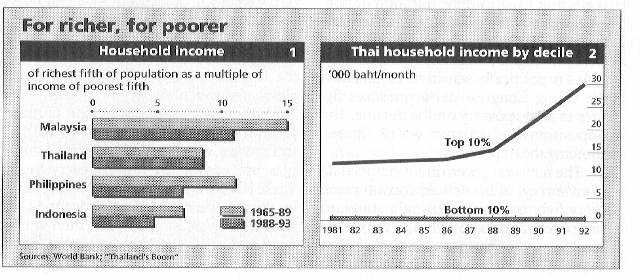
ARGUMENTATION - CHANGE - 1
Source: Economist - carenini@cs.pitt.edu
SPECIFIC EVENT: Economic miracle (65-today)
SPECIFIC EFFECT: Increased wealth
SPECIFIC QUESTION: Is it true that in South-East Asia the increase in wealth due to the economic miracle has led to increased equality in the distribution of wealth?
This presentation challenges the answer that most economists give : "Yes, in South-East asia (an aggregate) increased wealth has led to increased equality."
First, by disaggregating South-East Asia into the different countries, chart1 shows that there are noticeable differences between countries in how increased wealth has led to increased equality and in particular that in Thailand equality did not increase at all. Second, chart2 by focusing on narrower segment of Thai society indicates a widening wealth gap.
Chart 1 compares aggregates respect to 65-89 /88-93 years and richest fifth/poorest fifth.
Chart 2 no aggregation by year, aggregate richest 10%/poorest 10%, only for Thailand
COMMENTS: This presentation shows how the choice of particular aggregation/disaggregations can support opposite arguments.
TEXT:"The extent of Thailand's wealth gap depends on how you measure it. Recent World bank figures, comparing the wealth of the top fifth of the population with that of the bottom fifth, suggest that income distribution in the early 1990s was no more unequal than in the 1970s (see chart 1). Other studies, however, which focus on narrower segments of Thai society-the richest and the poorest 10% of the population- do show a widening wealth gap. According to a paper by Yukio Ikemoto, a Japanese economist, the share of national income of the richest 10% of Thais in 1981 was 17 times that of the poorest 10%. By 1992 the multiple was 38 (see chart 2)
